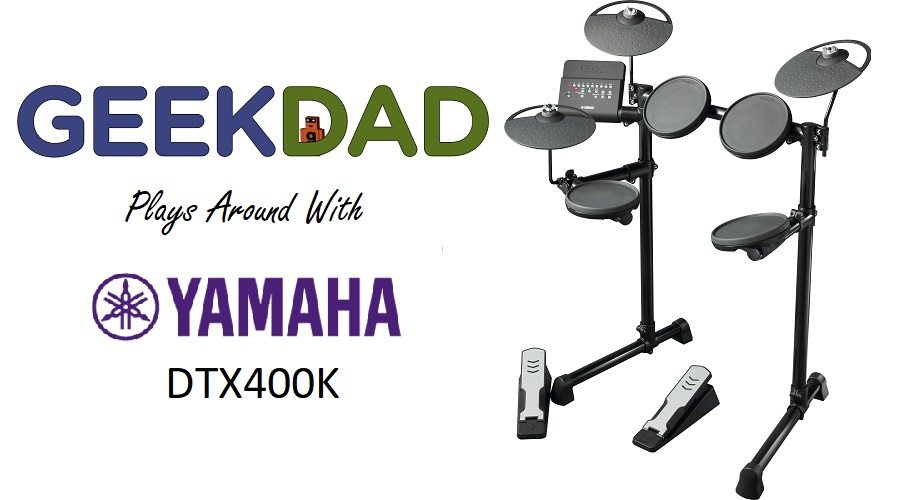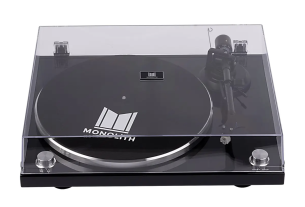Recently, I was given the opportunity to test out Yamaha’s DTX400K electronic drum kit. I’m not going to lie; no one in my family is a drummer. My wife and daughter play the piano and a Chinese stringed instrument called the guzheng, and my son has been talking about learning the drums for a while now. Buying into a drum kit is a serious investment, though – not only in financial terms but also with respect to space, as GeekMom Nivi discovered when she reviewed the Yamaha Rydeen Drum Kit.
These things aren’t small. So this was the perfect opportunity to give his interest a test run.
With that in mind, we’re going to take a look at the DTX400K from a beginner’s point of view. How good is it for a total newb? As a parent, is this a good choice for your kids? What are its pros and cons versus a traditional acoustic kit, and is it a suitable substitute?
Not to rush to the end, but this is a great unit and should absolutely be on your shortlist if you’re in the market for a beginner (or intermediate) drum kit.
As a parent, the early days of any new instrument is always a worrisome prospect. The screeching violin. The honking clarinet. The deafening cacophony of a drum kit. For that last one, at least, there’s finally a solution. If your kid wants to learn the drums, going the electronic route is probably the best decision you can make.
Why? One word: headphones.
The Yamaha DTX400K doesn’t come with built-in speakers, so you need to either hook it up to an amp/external speakers or you can plug in headphones. Which, let’s be honest, is all kinds of awesome when the kid is just banging away with little rhythm or sense. The very thought of my 6-year-old son crashing away on snares and cymbals is, frankly, a little terrifying to me. The ability to avoid that disruption and go on “silent running” with headphones is – to me – the biggest selling point.
And if you live in an apartment or a townhouse with shared walls? This is a no-brainer. You NEED to have the ability to plug in and play silently.
Another huge issue that comes into play when considering a drum kit is space. I get it – not everyone has the room to set up a full kit. I certainly don’t. Those things are big!
Thankfully, the DTX400K has a relatively small footprint and can easily slide into a corner. The unit itself only weighs about 22 pounds, so it’s fairly easy to move and transport. So if you want to store it in a closet and only bring it out for practice, that’s totally doable. Disassembling the entire thing for transport (if you need to take it somewhere else) might take you a little while, but no special tools are required, and all of the pieces (plus cords) are clearly labeled.
To give you some sense of scale, here’s the DTX400K beside a Rock Band 2 drum kit, which – surprisingly – takes up about the same amount of space:

If you buy online, you might be wondering how the kit will arrive at your door. We put together this “unboxing” video to show what to expect and a quick look at the (surprisingly easy) assembly process.
So now that the biggest selling points are out of the way, what can you really expect from this thing? How versatile is it? How easy is it to learn?
Straight out of the box, it comes with 10 pre-programmed (but editable) drum kits composed of 169 different sounds. Those sounds include 23 snares, 21 kicks, 36 toms, 31 cymbals, 16 hi-hats, and 42 percussions. So you’re certainly not at a loss for unique sounds to replicate any number of drum kits. It also comes with 10 practice songs that cover a range of genres. (You can add new MIDI songs, as well.)
Another advantage the DTX400K has over a traditional kit is the robust set of training exercises that are built in. Check here for more details on all of the activities it offers, but as an example, here’s how Groove Check (one of the more basic training exercises) works:
These training activities are incredibly helpful for beginners who might have difficulty maintaining a rhythm or keeping time in check. If you’re teaching yourself or practicing without an instructor beside you, these activities are invaluable to master the basics.
How does it sound? To my ear, it sounds just like a traditional kit. Your kid likely won’t even notice the difference. So in short, it sounds good. Really good. The old man in me is amazed at how far the technology has come that I have an electronic drum kit sitting beside an electronic keyboard, and both sound just as good as their analog counterparts.
One other thing I should mention is the kit’s durability. If your kid maintains an interest in drums, it will probably last way longer than a cheap set from a big box store. And if he or she loses interest in drums? An electronic drum kit is MUCH easier to unload on eBay or Craigslist (or wherever), and you’re likely to get a price close to what you paid.
So, bottom line: is this a good substitute for a traditional kit? If you’re looking for versatility, convenience, a small footprint, and the ability to go on “silent running,” then you can’t go wrong here. And for the price (the DTX400K has an MSRP of around $800, but it’s significantly cheaper on Amazon), it’s a fraction of the cost of an acoustic kit.
(Disclosure: For the purposes of this review, Yamaha provided us with a loaner unit to try out. All opinions remain our own.)





Parents should note that, while headphones do cut down on the noise, they don’t totally eliminate it. Physics is still alive and well when those sticks hit the pads. There’s going to still be some sound generated.